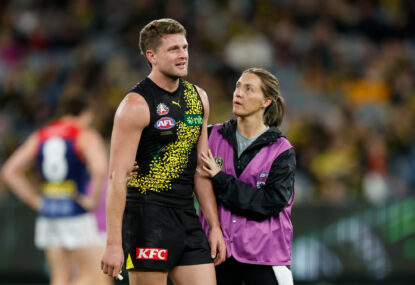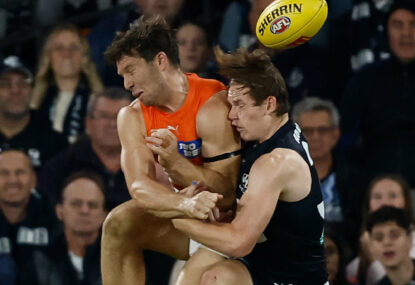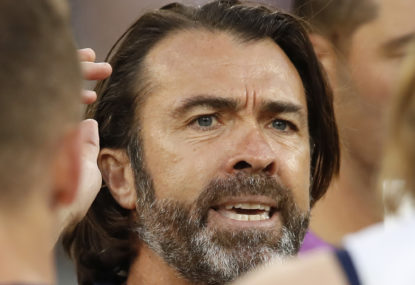Collingwood enter 2017 with midfield quality so deep that Champion Data rated it the best in the game. But in the process of securing their raft of on-ballers and small forwards, they have left gaping holes in their spine.
After last October’s spring clean, where the Pies farewelled many key position players – both forced and unforced – the quality and quantity of Collingwood’s tall stocks is a lingering question.
But how big is the problem and how vulnerable are they?
If you look at the AFL player rankings from the end of 2016, it doesn’t make for pleasant reading.
According the AFL website, the rankings work by “assessing every single action of every player, determining the impact of that action, and providing points – either positive or negative – toward that player’s rating compared to his peers.”
There is also heavier weightings on your past 30 games, and it only factors in the last two seasons of AFL football.
In short; if you have an impact on the game frequently and positively, can stay on the park, and you’ve done your best work recently, you will be rewarded.
Currently, Collingwood has only one player that ranks in the top 25 for key defenders and forwards. Of the key defenders on Pies list Lynden Dunn ranks 30th, which is a tribute to his durability. Ben Reid ranks 33rd – his best is much better than that when fit, but he justifiably slips due to his chronic injuries.
Then it falls away. Henry Schade, a rookie discard from the Gold Coast, comes in at 56th, Sam McLarty is yet to play a game, and Lachie Keefe is returning from a two-year lay-off. Jeremy Howe and Tyson Goldsack will support this group, but are not considered key position.
Of the forwards, great white hope Darcy Moore sits at 33, certain to be climb higher as the year goes on. American Mason Cox is 50, and other than White, presents the only tall foil for Moore in the forward line that would command any attention.

Chris Mayne is not key position but will be asked to play the third tall, and his impact on the forward line will be the most intriguing subplot of Collingwood’s year.
In the ruck division there is good news and bad news. Brodie Grundy ranks ninth, but given his age and scope for improvement, it would be easy to see him in the top five by year’s end.
The bad news is there is no spare ruckman on the primary list since the departure of Jarrod Witts. Cox and Keefe will pinch hit, but then it falls to rookies Mitch McCarty and Max Lynch.
To put this into perspective, the other teams not represented in the top 25 of key defenders are Essendon and Fremantle. The Bombers will welcome back Michael Hurley and Cale Hooker, while Fremantle acquired the rapidly improving Joel Hamling, and Michael Johnson is returning from his hamstring troubles.
Fremantle and Carlton do not appear in the top 25 for key forwards, but again the Dockers have tried to address this in the off season and should improve. As for the Blues, they are a work in progress and have brought in many young key position talents, several of whom will feature on this list in years to come.
So what does all this mean? For starters, these numbers are not perfect and they do spit out some weird anomalies (Justin Westhoff is a higher ranking key forward than West Coast’s Josh Kennedy for example), but it does give a snapshot into how a club is faring in particular positions, and currently Collingwood is rated 17th for key defenders, and 12th for key forwards.
And those ratings don’t seem that absurd either. What if Ben Reid can’t shake his persistent injuries? What if Darcy Moore is double and triple teamed out of games? What if Brodie Grundy goes down? Who can step up and fill the void?
Another consideration in this argument is that football is now rarely a one-on-one contest; teams work as a unit to defend, create turnovers, score, lock the ball in. When done well, this elevates teams to be greater than the sum of their parts.
The Bulldogs of 2016 were a classic example of this: on paper, they didn’t have the size or capability to stop the highly rated Swans, but their midfield hunted and pressured the ball relentlessly, which gave defenders time to support and outnumber.
Outcomes like this however are reliant on continuity of the playing group over a number of years, something Collingwood hasn’t been able to foster due to form and injury. Again this season, they have players returning from long injury spells and a sprinkling of new recruits, all who would consider themselves best 22.
The story for this Collingwood list is yet to be written, and there will be variables that determine whether Nathan Buckley can arrest the slide down the ladder. Injury is always an important factor, and this year they have an acute reliance on certain players staying on the park.
Even if all goes to plan though, the Pies have left themselves vulnerable to pretty much every team they will be competing with for spots in the top eight, if their opposition can stretch the Pies’ undersized defence at one end, and negate their tall forwards at the other.





































































































